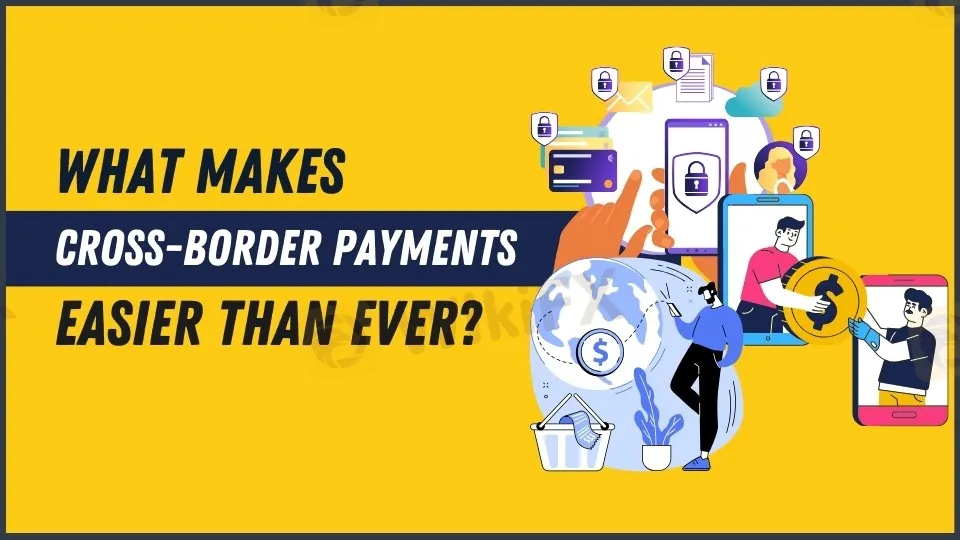简体中文
繁體中文
English
Pусский
日本語
ภาษาไทย
Tiếng Việt
Bahasa Indonesia
Español
हिन्दी
Filippiiniläinen
Français
Deutsch
Português
Türkçe
한국어
العربية
What Makes Cross-Border Payments Easier Than Ever?
Abstract:Cross-border payments are now faster, cheaper, and simpler! Explore fintech, blockchain, and smart solutions to overcome costs, delays, and global payment hurdles.

The world is more connected than ever before, with firms daily transacting across geographical, cultural, and financial boundaries. Cross-border payments have become an important aspect of the global economy for everyone from multinational enterprises to small firms expanding into new markets. However, as recently as a decade ago, moving money across borders was sometimes slow, costly, and inefficient.
Today's narrative is different. Technology advancements, combined with purposeful policy adjustments, have made cross-border payments more seamless and accessible than ever before. Businesses can now make payments to partners, suppliers, and employees all across the world in a fraction of the time and expense it used to take. But what's propelling this transformation? Are there still obstacles to overcome? This essay investigates how cross-border payments have evolved, the problems that firms face, and the technologies that make worldwide transactions easier.
What Barriers Do Businesses Face When Making Cross-Border Payments?
Despite advancements, cross-border payments are not without challenges. Businesses, particularly small and medium-sized enterprises (SMEs), frequently find the process overwhelming due to a number of chronic challenges. Understanding these issues is the first step toward effective problem-solving.
· High Transaction Costs
The high cost of international payments is one of the most important impediments for firms that deal with them. Traditional financial organizations, such as banks, frequently charge high costs for set transaction fees, percentage-based service fees, and unfavorable currency conversion rates. These charges can dramatically reduce profit margins for small firms and startups on a tight budget.
Furthermore, hidden costs from intermediate banks, which facilitate transactions between the sender's and receiver's banks, exacerbate the financial hardship. The cumulative expense for organizations that make regular foreign payments can be prohibitively expensive.
· Slow Processing Times
Speed is sometimes essential in today's fast-paced global economy, but typical cross-border transfers are anything but. Legacy systems can process payments in three to five business days, with delays caused by time zone differences, varied bank operation hours, and the requirement for various intermediaries. This slow pace can disrupt supply chains, cause payroll delays, and damage relationships with multinational partners.
· Regulatory Complexity
Cross-border payments are governed by a complex set of regulations that vary per country. Anti-money laundering (AML) and counter-terrorism financing (CTF) regulations are just the beginning. Businesses must also handle tax restrictions, foreign exchange reporting, and data privacy laws. Compliance can be expensive and time-consuming for organizations that are new to these frameworks, with the added danger of penalties for noncompliance.
· Currency Fluctuations
Managing different currencies presents unique issues. Exchange rates can move fast, often within hours, making the amount of money received or paid by firms unpredictable. For example, a corporation may commit to a €10,000 payment only to realize that a little change in exchange rates affects the value received in their own currency. Hedging tactics can help to reduce risk, but they frequently necessitate complex tools and expertise that not all firms have.
· Lack of Transparency
Traditional payment systems frequently fail to provide real-time tracking or detailed information about transaction status. Businesses are left in the dark about when their cash will arrive, who handled it along the route, and how fees are allocated. The absence of openness affects confidence and hampers financial planning.

The Technologies Revolutionizing Cross-Border Payments
The challenges of the past have encouraged creativity in the area of cross-border payments. From blockchain technology to AI-powered platforms, new solutions are solving inefficiencies and enabling organizations to prosper on a global scale.
· Blockchain and Cryptocurrency
Blockchain technology is revolutionizing the way international payments are processed. Blockchain cuts transaction prices and processing times by removing intermediaries while boosting transparency. Cryptocurrencies such as Bitcoin and Ethereum, as well as stablecoins such as USDC, enable quick cross-border money transfers. Blockchain-based smart contracts increase trust and security by guaranteeing payments are only executed when certain criteria are met.
· Digital Payment Platforms
PayPal, Wise (previously TransferWise), and Stripe have transformed cross-border payments by providing user-friendly platforms that dramatically cut prices and processing times. These platforms employ novel methods to circumvent established banking networks, resulting in more competitive exchange rates and speedier transactions.
· API Integration
Businesses can integrate payment processing into their platforms for a more seamless customer experience. E-commerce businesses, for example, can allow customers to pay in their native currency, with automatic conversions and clear fees.
· AI and Machine Learning
AI systems improve cross-border payment security and compliance. Machine learning algorithms can detect fraudulent activities in real-time, assess risk, and assure compliance with international rules. Furthermore, AI assists firms in predicting currency swings, allowing for more accurate financial planning.
· Central Bank Digital Currencies (CBDCs)
To modernize financial institutions, central banks throughout the world are testing digital versions of their currencies. CBDCs aim to simplify cross-border payments by introducing a government-backed digital currency that eliminates many of the inefficiencies associated with traditional payment methods.
The Benefits of Modern Cross-Border Payments
Innovations in cross-border payment technologies provide previously inconceivable advantages. Businesses that use these advancements can benefit from:
· What's Next for Cross-Border Payments?
The future of cross-border payments is really promising. Blockchain scalability, CBDC acceptance, and AI advancements are all projected to lead to even greater gains. Businesses must be watchful, responding to legal changes and technology improvements on a regular basis.
Collaboration among fintech firms, regulators, and traditional financial institutions will be critical to overcoming lingering problems. As this ecosystem develops, businesses of all sizes will gain access to cross-border payment options that are efficient, secure, and cost-effective.
Final Thoughts
Cross-border payments are no longer limited to huge enterprises with significant resources. Because of significant technological improvements, businesses of all sizes may now conduct international transactions with confidence. While challenges like as regulatory complexity and currency fluctuations exist, today's solutions are changing the way money travels across borders.
For companies looking to extend their global footprint, the tools and technology that are altering cross-border payments provide an unparalleled opportunity. Companies that embrace these advances can enter new markets, strengthen international alliances, and lay a solid platform for future success. The path to seamless global business is well on, and the opportunities are infinite.

Disclaimer:
The views in this article only represent the author's personal views, and do not constitute investment advice on this platform. This platform does not guarantee the accuracy, completeness and timeliness of the information in the article, and will not be liable for any loss caused by the use of or reliance on the information in the article.
Read more

Tradu Introduces Tax-Efficient Spread Betting for UK Traders
Tradu’s introduction of tax-efficient spread betting and groundbreaking tools like the Spread Tracker signals a new era of accessible, competitive, and innovative trading solutions for UK investors.

Trading Lessons Inspired by Squid Game
The popular series Squid Game captivated audiences worldwide with its gripping narrative of survival, desperation, and human nature. Beneath the drama lies a wealth of lessons that traders can apply to financial markets. By examining the motivations, behaviours, and strategies displayed in the series, traders can uncover valuable insights to enhance their own approach.

RM5.9M Lost to "Davidson Kempner Capital Management" Facebook Scam
A private contractor in Malaysia faced a devastating loss of over RM5.9 million after falling victim to a fraudulent investment scheme promoted on Facebook. Tempted by the scheme’s impressive claims and credentials, the victim began investing in September 2024. The investment process required him to download an application called A-Trade, which was readily available on the Apple Store.

Challenge Yourself: Transform from Novice to Expert
From a forex novice to a trading expert, all it takes is this one opportunity! Join us for the Forex Beginner's Advancement Journey challenge and unlock your potential! Here, if you're a beginner, participating in the event and posting on selected topics will not only deepen your understanding of forex basics and help you advance but also earn you a Learning Encouragement Award. For those with some experience in forex, discussing insights under the event topics will allow you to exchange experiences and share techniques with like-minded peers, while also having the chance to win a Perspective Sharing Award! Come challenge yourself and break through the limits of forex trading together!
WikiFX Broker
Latest News
SQUARED FINANCIAL: Your Friend or Foe?
Big News! UK 30-Year Bond Yields Soar to 25-Year High!
High-Potential Investments: Top 10 Stocks to Watch in 2025
Why Is Nvidia Making Headlines Everywhere Today?
Discover How Your Trading Personality Shapes Success
US Dollar Insights: Key FX Trends You Need to Know
FINRA Charges UBS $1.1 Million for a Decade of False Trade Confirmations
BI Apprehends Japanese Scam Leader in Manila
Bitcoin in 2025: The Opportunities and Challenges Ahead
Join the Event & Level Up Your Forex Journey
Currency Calculator






